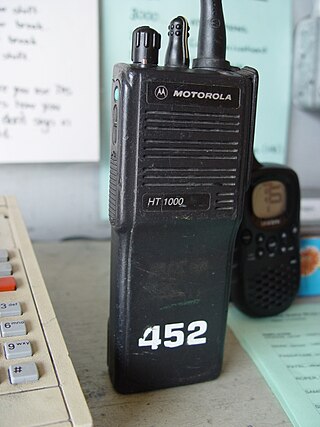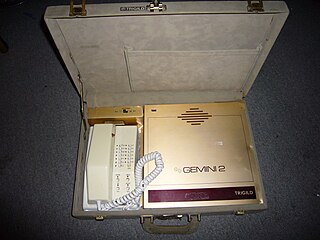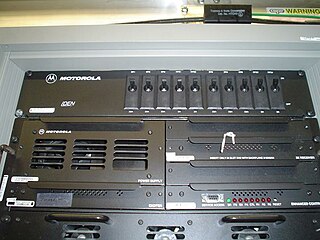
Communication problems and successes played an important role during the September 11 attacks in 2001 and their aftermath. Systems were variously destroyed or overwhelmed by loads greater than they were designed to carry, or failed to operate as intended or desired.
In telecommunications, squelch is a circuit function that acts to suppress the audio output of a receiver in the absence of a strong input signal. Essentially, squelch is a specialized type of noise gate designed to suppress weak signals. Squelch is used in two-way radios and VHF/UHF radio scanners to eliminate the sound of noise when the radio is not receiving a desired transmission.
Carrier-sense multiple access (CSMA) is a medium access control (MAC) protocol in which a node verifies the absence of other traffic before transmitting on a shared transmission medium, such as an electrical bus or a band of the electromagnetic spectrum.
Direct memory access (DMA) is a feature of computer systems that allows certain hardware subsystems to access main system memory independently of the central processing unit (CPU).
In telecommunications, Continuous Tone-Coded Squelch System or CTCSS is one type of in-band signaling that is used to reduce the annoyance of listening to other users on a shared two-way radio communication channel. It is sometimes referred to as tone squelch or PL for Private Line, a trademark of Motorola. It does this by adding a low frequency audio tone to the voice. Where more than one group of users is on the same radio frequency, CTCSS circuitry mutes those users who are using a different CTCSS tone or no CTCSS.
In telecommunications, trunking is a technology for providing network access to multiple clients simultaneously by sharing a set of circuits, carriers, channels, or frequencies, instead of providing individual circuits or channels for each client. This is reminiscent to the structure of a tree with one trunk and many branches. Trunking in telecommunication originated in telegraphy, and later in telephone systems where a trunk line is a communications channel between telephone exchanges.

Professional mobile radio are person-to-person two-way radio voice communications systems which use portable, mobile, base station, and dispatch console radios. PMR systems are based on such standards as MPT-1327, TETRA, APCO 25, and DMR which are designed for dedicated use by specific organizations, or standards such as NXDN intended for general commercial use. These systems are used by police, fire, ambulance, and emergency services, and by commercial firms such as taxis and delivery services. Most systems are half-duplex, in which multiple radios share a common radio channel, and only one can transmit at a time. Transceivers are normally in receive mode, the user presses a push-to-talk button on his microphone when he wants to talk, which turns on his transmitter and turns off his receiver. They use channels in the VHF and UHF bands, giving them a limited range, usually 3 to 20 miles depending on terrain. Output power is typically limited to 4 watts. Repeaters installed on tall buildings, hills or mountain peaks are used to increase the range of systems.

The Improved Mobile Telephone Service (IMTS) was a pre-cellular VHF/UHF radio system which linked to the public telephone network. IMTS was the radiotelephone equivalent of land dial phone service. Introduced in 1964, it replaced Mobile Telephone Service (MTS) and improved on most MTS systems by offering direct-dial rather than connections through a live operator, and full-duplex operation so both parties could talk at the same time.
In electrical signalling an analog current loop is used where a device must be monitored or controlled remotely over a pair of conductors. Only one current level can be present at any time.

A trunked radio system is a two-way radio system that uses a control channel to automatically assign frequency channels to groups of user radios. In a traditional half-duplex land mobile radio system a group of users with mobile and portable two-way radios communicate over a single shared radio channel, with one user at a time talking. These systems typically have access to multiple channels, up to 40-60, so multiple groups in the same area can communicate simultaneously. In a conventional (non-trunked) system, channel selection is done manually; before use, the group must decide which channel to use, and manually switch all the radios to that channel. This is an inefficient use of scarce radio channel resources because the user group must have exclusive use of their channel regardless of how much or how little they are transmitting. There is also nothing to prevent multiple groups in the same area from choosing the same channel, causing conflicts and 'cross-talk'. A trunked radio system is an advanced alternative in which the channel selection process is done automatically, so as to avoid channel conflicts and maintain frequency efficiency across multiple talkgroups. This process is handed by what is essentially a central radio traffic controller, a function automatically handled by a computer system.
A duplex communication system is a point-to-point system composed of two or more connected parties or devices that can communicate with one another in both directions. Duplex systems are employed in many communications networks, either to allow for simultaneous communication in both directions between two connected parties or to provide a reverse path for the monitoring and remote adjustment of equipment in the field. There are two types of duplex communication systems: full-duplex (FDX) and half-duplex (HDX).

An amateur radio repeater is an electronic device that receives a weak or low-level amateur radio signal and retransmits it at a higher level or higher power, so that the signal can cover longer distances without degradation. Many repeaters are located on hilltops or on tall buildings as the higher location increases their coverage area, sometimes referred to as the radio horizon, or "footprint". Amateur radio repeaters are similar in concept to those used by public safety entities, businesses, government, military, and more. Amateur radio repeaters may even use commercially packaged repeater systems that have been adjusted to operate within amateur radio frequency bands, but more often amateur repeaters are assembled from receivers, transmitters, controllers, power supplies, antennas, and other components, from various sources.

A radio repeater is a combination of a radio receiver and a radio transmitter that receives a signal and retransmits it, so that two-way radio signals can cover longer distances. A repeater sited at a high elevation can allow two mobile stations, otherwise out of line-of-sight propagation range of each other, to communicate. Repeaters are found in professional, commercial, and government mobile radio systems and also in amateur radio.
Motorola Type II refers to the second generation Motorola trunked radio systems that replaced fleets and subfleets with the concept of talkgroups and individual radio IDs. There are no dependencies on fleetmaps, therefore there are no limitations on how many radio IDs can participate on a talkgroup. This allows for greater flexibility for the agency. When scanning Motorola IDs, each Type II user ID appears as an even 4- or 5-digit number without a dash.
GE Marc V is a historic U.S. format or protocol of trunked, two-way radio introduced by General Electric Mobile Radio in the early 1980s. This equipment was also sold in Australia. The product name looks and sounds similar to GE-Mark V, a turbine controller made by General Electric. GE developed the EDACS radio system based on its success with Marc V.
The introduction of Motorola Type II SmartZone introduced the IntelliRepeater. An IntelliRepeater, or IR, site is a bare-bones trunked site which has no database of users or talkgroups. It is simply sophisticated software running on a Quantar repeater. It is meant to be controlled by the Zone Controller and to be commanded as to who has permission and who does not. There are some very basic restrictions in the event Site Trunking does occur but for all intents and purposes once an IR site is in Site Trunking mode it's a free-for-all site.
Within radio technology, LTR Standard systems have no dedicated control channel. All control data is sent as subaudible data along with voice transmissions. Each system site can have any number of radio channels from 1 through a maximum of 20. Each channel is made up of one channel controller connected to one radio repeater operating on one frequency. One controller is assigned as the master or system controller and all the other controllers report to it via a trunking data buss. This connection allows all the repeaters at a site to operate as one LTR system.
PassPort is a type of LTR Trunked radio system designed by Trident Micro Systems, which consists of multiple radio repeater sites linked together to form a wide-area radio dispatch network.
LTR MultiNet Systems are APCO-16 compliant LTR Trunked Radio Systems and thus are mostly found in use as public safety systems. LTR MultiNet systems usually have one or more "status channels" that act like a control channel in a Motorola or EDACS system, however these channels can also carry voice transmissions simultaneously.
In a conventional, analog two-way radio system, a standard radio has noise squelch or carrier squelch, which allows a radio to receive all transmissions. Selective calling is used to address a subset of all two-way radios on a single radio frequency channel. Where more than one user is on the same channel, selective calling can address a subset of all receivers or can direct a call to a single radio. Selective calling features fit into two major categories—individual calling and group calling. Individual calls generally have longer time-constants: it takes more air-time to call an individual radio unit than to call a large group of radios.





